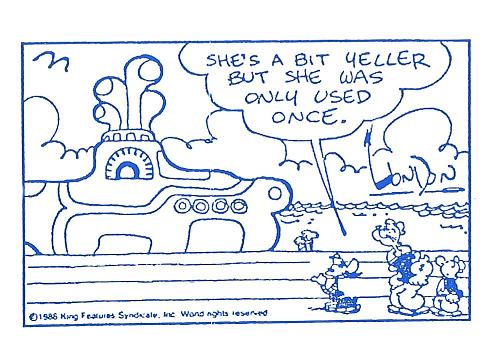The Yellow Submarine Chronicles Part Eight: It’s All Too Much
The thirtieth anniversary of Yellow Submarine in 1998 saw a resurgence in popularity that even the Beatles and MGM could not have anticipated. Fans were eager to recapture this portion of Beatlemania and Yellow Submarine CDs, videos, and all manner of related merchandise lined store shelves.
Around this same time, the US Postal Service began a special series of stamps to 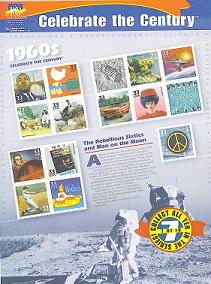 commemorate the past hundred years called Celebrate the Century. Each decade of the 1900’s was given its own sheet of fifteen stamps featuring key events in sports, politics, entertainment and history from the period. The Beatles were honored as one of the stamps for the 1960’s and, of all the images from the Fab Four’s career they could have selected, they chose the Yellow Submarine. Interestingly enough, the Beatles aren’t even on the stamp, just the nose cone of the vessel they made famous.
commemorate the past hundred years called Celebrate the Century. Each decade of the 1900’s was given its own sheet of fifteen stamps featuring key events in sports, politics, entertainment and history from the period. The Beatles were honored as one of the stamps for the 1960’s and, of all the images from the Fab Four’s career they could have selected, they chose the Yellow Submarine. Interestingly enough, the Beatles aren’t even on the stamp, just the nose cone of the vessel they made famous.
While 2008 may not have ushered in another wave of Yellow Submarine-mania to celebrate the 40th anniversary of the film, a steady undercurrent had been going strong for the past decade. Yellow Submarine merchandise has never dried up in the past ten years and new items are added all the time. The movie is currently unavailable on home video (once again) and commands increasingly higher prices on the secondary market. It is clearly only a matter of time before it surfaces again to entertain a new generation. For a film the Beatles only agreed to out of contractual obligation and that ended up being something completely different than it was originally envisioned, Yellow Submarine has become a pop icon in it’s own right. Many thanks to everyone who has joined me on this eight part journey from England to Pepperland with stops at all points in between. Full speed ahead Mr. Parker, full speed ahead!
A Tale of Two Tales
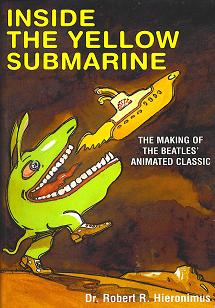 The Yellow Submarine Chronicles would not have been possible (or at least wouldn’t have been nearly as interesting) without the help of two recently published books about the film’s origins.
The Yellow Submarine Chronicles would not have been possible (or at least wouldn’t have been nearly as interesting) without the help of two recently published books about the film’s origins.
The first is Inside the Yellow Submarine by Dr. Robert Hieronimus, an incredibly well researched and detailed diatribe. Hieronimus spent years gathering this information together and interviewed almost everyone ever associated with the production. The book is intentionally filled with contradictory information as each participant is given the opportunity to tell their own story. It also contains tons of rare test drawings and sketches for scenes that never made it into the film, like Ringo meeting Batman! This is a highly recommended book for anyone who wants to learn more about the film.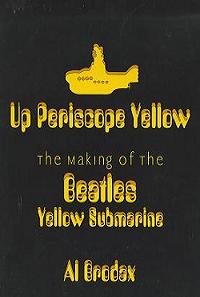
The second book on the subject is Up Periscope Yellow by Al Brodax. This first hand account of one key person’s observations and experiences is almost the complete opposite of Hieronimus’s approach. Brodax is focused on telling his version of the facts in a highly suspect but also highly entertaining way. If viewed in the same light as an average television docudrama, Periscope is a fun read with some hilarious stories.
The Final Word from a Member of the Yellow Submarine Crew
Of all the hundreds of writers, artists, designers and support personnel who worked incredibly grueling hours for months on end on the labor of love that became Yellow Submarine, one man stands above all others. One man had the vision to look beyond the ordinary and create an animated feature film unlike any other. One man was the driving force that propelled the project forward despite all manner of seemingly insurmountable obstacles. Robin Shepherd was not that man but he does occasionally get mistaken for him! The good natured Shepherd was one of countless young animators who spent a brief period of time coloring cells for the film. Unlike most of the people associated with the project though, he got a chance to illustrate the submarine again thirty years later. As a brief encore, Mr. Shepherd, who now has his own advertising firm, The Robin Shepherd Group, in Jacksonville, Florida, was kind enough to give us a few insights into his brief time aboard the Yellow Submarine.
ED Tucker: How did you become involved with animating the film Yellow Submarine?
Robin Shepherd: I lived in London for eight years. I left in 1972 so I was right in that 1968 corridor. I worked on Yellow Submarine completely by accident. I think everyone knew it was going on at the time and I was very interested in animation. I was fortunate enough to meet a man named Norman Drew who got me the job. He was a Canadian and he was working on Yellow Submarine. He was what they would term as an “in-betweener”. One person would draw one image and then another person would draw a finished image. An “in-betweener” would do the images in between those two images and then animate them to make them work. It’s a really interesting job because they break it up into very simple sections. There were sections that I never even saw, never even knew they were there. Until I saw the film years later, I didn’t even know half of it was going on because they broke it up, I’m guessing, into about eight different styles or parts.
ET: They had different units producing different segments of the film simultaneously.
RS: They almost did the movie like you would do a long playing record, with each track being its own thing. Let’s face it; they had a great music store to draw from. What they ended up with has a theme running through it but there are also independent styles for each song being performed. I was in a very elementary point of just coloring in cells at sort of an hourly rate of like one pound every six days! I don’t know what it was exactly but it was insanely cheap. I remember coloring in a lot of Blue Meanies. I was working in these off shoot places that were not where the rest of the movie was being made. I believe that was being done in Soho and these were sort of adjunct places. They would literally hire a small hall and have twenty five people coloring or doing something or other.
ET: Did you work with any of the key creators of the film?
RS: The only person I ever saw who was a creative force behind the film was a very surrealistic Director who was usually in his pajamas walking through at eight o’clock at night.
ET: That would be Art Director Heinz Edelmann?
RS: Yes. I will divert for just click, if you don’t mind, and say that Heinz Edelmann was either the original or a derivative of a German / Swiss illustration school that Milt Glaser ripped off. Milton Glaser was a giant in America. He did these beautiful record covers for Dylan and all sorts of things. It was his style that was being sucked out of Eastern Europe.
ET: Would you say that Peter Max was another person with that kind of style?
RS: Absolutely. It was definitely an Eastern European style that was very colorful and crazy but had a real hard edge to it. It had an interesting kind of irony to it. You still see animations to this day that come out of that part of the world that have a cruelty and beauty at the same time. Back to the movie, my work on Yellow Submarine was really infinitesimal. People were hired and fired daily and weekly. I probably worked there for about a month. I never really got to know anything except that the intermediary people I worked with sort of came and went. It was kind of like working for Manpower for the Beatles!
ET: So you were the temporary help for the Beatles.
RS: Yes, I didn’t get to be very creative but it did get me what I wanted. After that I went to work for the BBC doing what they call “pug wash” animation. It was very limited animation. An eyeball or an arm might move but it was very static. They were cut out drawings that move a little bit like in the early days. It’s all they could afford to do at the BBC for kid’s television. I worked for a show called Blue Peter and I wrote and animated these “pug wash” pieces.
ET: Similar to the limited animation on South Park now?
RS: Very similar. While I was there, the BBC didn’t have an Oxberry camera, which was state of the art to film on at the time, so I had to go to another studio. Terry Gilliam, of Monty Python, was working at this other studio that I can’t remember the name of. He told me what his secret was. He was basically buying and blowing up and down, Sears catalogs. These were ones from around the turn of the century that had highly stylized engravings. They were interesting because they were funny looking to begin with – weird shoes, corsets, and things like that. That was where his humor came from. When I was at the studio he was just moving this stuff around and filming it.
ET: Was Yellow Submarine your first job in the animation industry?
RS: Yes, that overlapped with BBC a little bit. I also worked on another movie, doing the same type of thing, called the Jackson 5ive.
ET: Was that the cartoon series produced for television?
RS: Yes, that was after Yellow Submarine. I think Yellow Submarine actually broke some boundaries which was sort of nice. Up until then I think animation had strictly been for kids. It had never been used as a graphic arts type of hip medium.
ET: Did you keep anything from when you worked on Yellow Submarine?
RS: I did keep a couple of cells but over time they start sticking together. They’re gone with the wind now!
ET: Do you remember when you first saw the completed film?
RS: I don’t think I ever saw the film in England, I think it was much later when I was living in America. It was in a theater in Jacksonville. Of course, any tiny piece that I had on it went by in about a third of a second. Oh, that was a Blue Meanie! That was the order of the day, Blue Meanies and maybe and Apple Bonker or two.
ET: Did you move directly from London to Jacksonville?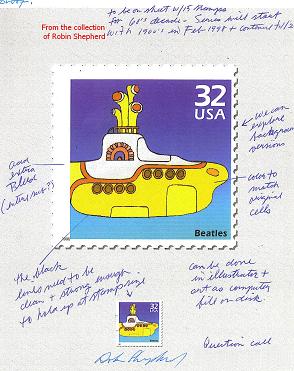
RS: Yes, my first wife was from Jacksonville and I met her while I was England. When I came to Jacksonville I worked for PBS and did some animation there for the school system.
ET: How did your involvement with the postage stamp come about?
RS: The way the Post Office works, they have twelve or fourteen designers that get together once a year and say “hey, let’s do the 60’s” or “let’s do wildlife” or whatever. They have creative control and they get to pick out a theme. The Post Office just wants to sell stamps but they really want to sell stamps to collectors not just to mail letters. I got a call from a guy in California. I run a design studio and I think their may have been an article in one of the trade magazines where it might have been quoted that I was born in Liverpool or something like that. He just called said “would I be interested?” I said “well yeah, there must be better qualified people than me but to slap a submarine on a stamp is something that would be very easy”. Funnily enough, it wasn’t that easy because we had to submit it and resize it. Then we had to worry about where the thirteen cents part went. We had to sign a lot of stuff saying we didn’t have any rights to it. It became more complex than I thought it would be. Never-the-less, I think it came out kind of nice and the one thing I have in my office is the stamp itself. They did a big banner of it when it was released. They hung this fifty foot banner in Liverpool. I don’t think this was just for the release of the stamp; it must have been for something bigger than that.
ET: 1998 was the thirtieth anniversary of the release of Yellow Submarine. I think it was just a coincidence that the Post Office decided to do their Celebrate the Century series at the same time. Since they wanted to include the Beatles as part of the 60’s it was an obvious choice. When they came to you to do the stamp did they tell you it had to have the submarine on it?
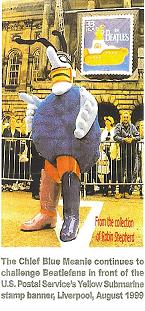 RS: I think they gave me a subtle hint to do that.
RS: I think they gave me a subtle hint to do that.
ET: I will tell you where I am going with this. In 1998, they also released a revised version of the film soundtrack on compact disc and the artwork featured on this and the video re-releases is very similar to the stamp.
RS: I have that disc. It’s pretty close to what we did for the stamp. They sent us a key line, which is in black and white but it has the colors keyed into it. We had to remake that because it was blurry and it just needed redoing. I think we talked about using shots from the film but it just didn’t make any sense not to have the submarine on it.
ET: You have a very limited area to work with on a stamp and if you had done anything more detailed that would have been lost when it was reduced.
RS: It’s a real art to making a stamp and I didn’t think about it at the time. There are a lot of things to consider. You submit it in a size that is close to 8 1/2 by 11 but when it comes down, lines start getting smaller and you need to beef it up. There has to be a certain width of line to it.
ET: Mr. Shepherd, thank you so much for sharing your memories of Yellow Submarine.
RS: You are welcome ED, I enjoyed the talk.
